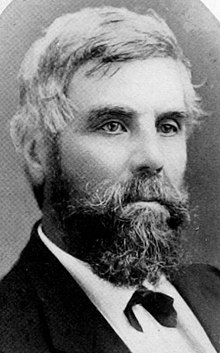John Hubbard Tweedy
John H. Tweedy | |
|---|---|
 From Volume 27 (1919) of Collections of the State Historical Society of Wisconsin | |
| Member of the U.S. House of Representatives from Wisconsin Territory's at-large district | |
| In office March 4, 1847 – May 28, 1848 | |
| Preceded by | Morgan L. Martin |
| Succeeded by | Henry H. Sibley |
| Member of the Wisconsin State Assembly from the Milwaukee 9th district | |
| In office January 1, 1853 – January 1, 1854 | |
| Preceded by | William Beck |
| Succeeded by | William E. Webster |
| Member of the Council of the Wisconsin Territory for Milwaukee and Washington counties | |
| In office December 6, 1841 – December 5, 1842 Serving with Don A. J. Upham | |
| Preceded by | Jonathan Earle Arnold |
| Succeeded by |
|
| Personal details | |
| Born | John Hubbard Tweedy November 9, 1814 Danbury, Connecticut |
| Died | November 12, 1891 (aged 77) Milwaukee, Wisconsin |
| Resting place | Wooster Cemetery Danbury, Connecticut |
| Political party | Whig |
| Alma mater | Yale University |
John Hubbard Tweedy (November 9, 1814 – November 12, 1891) was a delegate to the United States Congress from Wisconsin Territory from March 1847 to May 1848 being elected from the Whig Party. He was also the Whig Party nominee in first Wisconsin gubernatorial election, where he lost to Nelson Dewey.
Career
Tweedy was born in Danbury, Connecticut.[1] He graduated from Yale University in 1834, where he was a member of the secret society Skull and Bones.[2] He then moved to Milwaukee, Wisconsin Territory, in 1836, where he practiced law. He served in the Wisconsin Territorial Council, the upper house of the Wisconsin Territorial Legislature, in 1841–1842, and later served in the Wisconsin State Assembly in 1853. Tweedy was also a member of the first Wisconsin Constitutional Convention of 1846.
Tweedy was elected as a non-voting delegate to the Thirtieth Congress to represent the Wisconsin Territory, serving from March 4, 1847, until Wisconsin became a state on May 29, 1848. Tweedy was prominent in business involving railroads and public affairs. He died in Milwaukee, Wisconsin, aged 77, and was buried in Danbury, Connecticut.[3][4]
Private papers
His son, John H. Tweedy, Jr., donated his papers to the Wisconsin Historical Society.[5]
Notes
- ^ Minnesota History Bulletin Volume 2 (Google eBook) Theodore Christian Blegen, Minnesota Historical Society
- ^ Millegan, Kris (2003). "The Skeleton Crew". Fleshing Out Skull and Bones: Investigations into America's Most Powerful Secret Society. Walterville, OR: Trine Day. pp. 597–690. ISBN 0-9720207-2-1. "This list is compiled from material from the Order of Skull and Bones membership books at Sterling Library, Yale University and other public records. The latest books available are the 1971 Living members and the 1973 Deceased Members books. The last year the members were published in the Yale Banner is 1969."
- ^ Tweedy, John Hubbard 1814 - 1891
- ^ 'At His birthplace-John H. Tweedy's Remains to be Taken to Danbury, Conn., Wisconsin State Journal, November 14, 1891, pg. 1
- ^ The Wisconsin Magazine of History, Volume 2 (Google eBook)
External links
- United States Congress. "John Hubbard Tweedy (id: T000441)". Biographical Directory of the United States Congress.
- John Hubbard Tweedy at Find a Grave
- 1814 births
- 1891 deaths
- Delegates to the United States House of Representatives from Wisconsin Territory
- Members of the Wisconsin Territorial Legislature
- Members of the Wisconsin State Assembly
- Politicians from Danbury, Connecticut
- Lawyers from Milwaukee
- Politicians from Milwaukee
- Wisconsin Whigs
- Yale College alumni
- 19th-century American politicians
- Wisconsin United States Representative stubs
